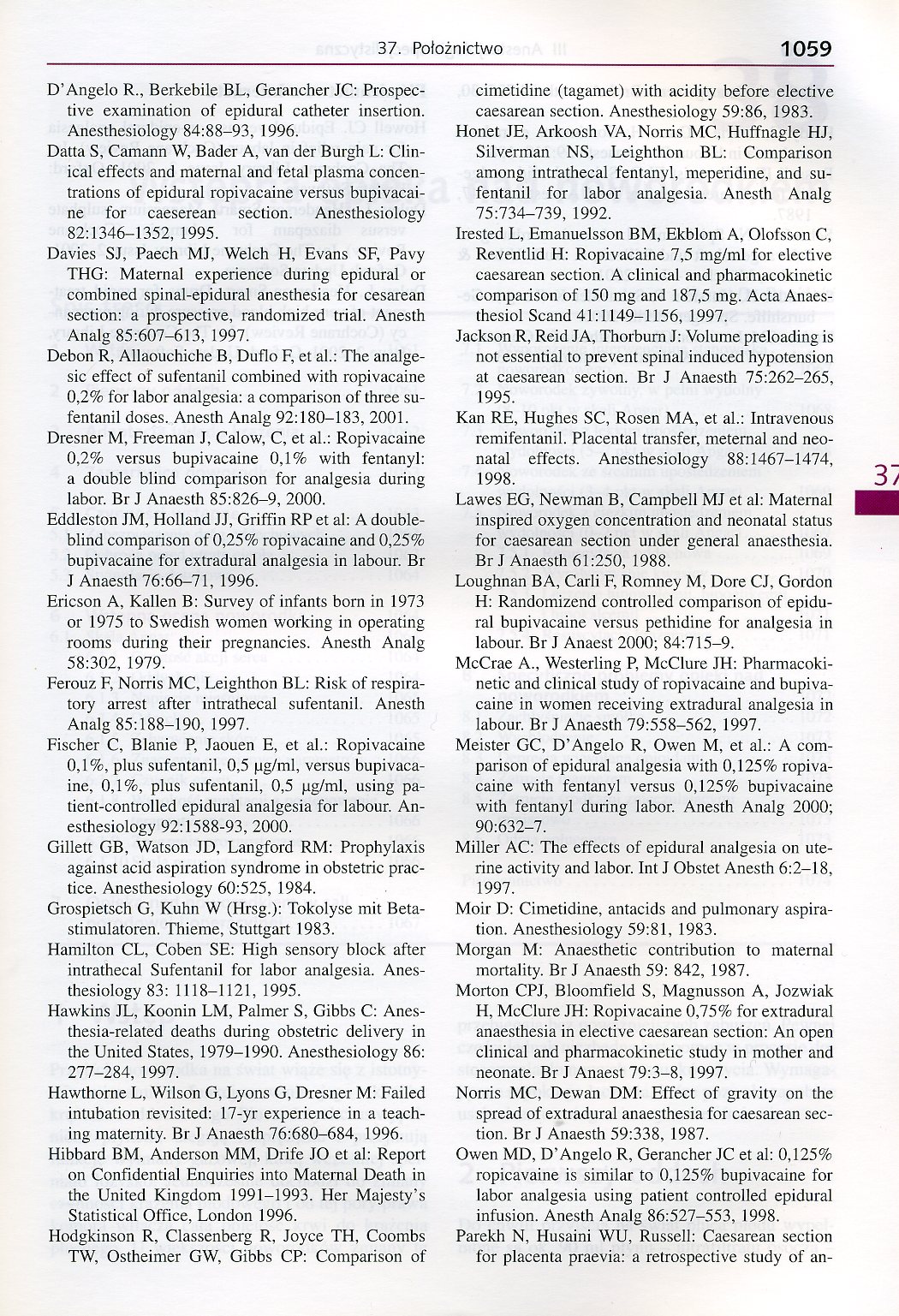larsen1059

37. Położnictwo 1059
D’Angelo R., Berkebile BL, Gerancher JC: Prospec-tive examination of epidural catheter insertion. Anesthesiology 84:88—93, I996.
Datta S, Camann W, Bader A, van der Burgh L: Clin-ical effects and matemal and fetal plasma concen-trations of epidural ropivacaine versus bupivacai-ne for caeserean section. Anesthesiology 82:1346-1352,1995.
Davies SJ, Paech MJ, Welch H, Evans SF, Pavy THG: Maternal experience during epidural or combined spinal-epidural anesthesia for cesarean section: a prospective, randomized trial. Anesth Analg 85:607-613, 1997.
Debon R, Allaouchiche B, Duflo F, et al.: The analge-sic effect of sufentanil combined with ropivacaine 0,2% for labor analgesia: a coniparison of three sufentanil doses. Anesth Analg 92:180-183, 2001.
Dresner M, Freeman J, Calow, C, et al.: Ropivacaine 0,2% versus bupivacaine 0,1% with fentanyl: a double blind comparison for analgesia during labor. Br J Anaesth 85:826-9, 2000.
Eddleston JM, Holland JJ, Griffin RP et al: A double-blind comparison of 0,25% ropivacaine and 0,25% bupivacaine for extradural analgesia in labour. Br J Anaesth 76:66-71, 1996.
Ericson A, Kallen B: Survey of infants bom in 1973 or 1975 to Swedish women working in operating rooms during their pregnancies. Anesth Analg 58:302, 1979.
Ferouz F, Norris MC, Leighthon BL: Risk of respiratory arrest after intrathecal sufentanil. Anesth Analg 85:188-190, 1997.
Fischer C, Blanie P, Jaouen E, et al.: Ropivacaine 0,1%, plus sufentanil, 0,5 pg/ml, versus bupivaca-ine, 0,1%, plus sufentanil, 0,5 pg/ml, using pa-tient-controlled epidural analgesia for labour. Anesthesiology 92:1588-93, 2000.
Gillett GB, Watson JD, Langford RM: Prophylaxis against acid aspiration syndrome in obstetric prac-tice. Anesthesiology 60:525, 1984.
Grospietsch G, Kuhn W (Hrsg.): Tokolyse mit Beta-stimulatoren. Thieme, Stuttgart 1983.
Hamilton CL, Coben SE: High sensory błock after intrathecal Sufentanil for labor analgesia. Anesthesiology 83: 1118-1121, 1995.
Hawkins JL, Koonin LM, Palmer S, Gibbs C: Anes-thesia-related deaths during obstetric delivery in the United States, 1979-1990. Anesthesiology 86: 277-284, 1997.
Hawthorne L, Wilson G, Lyons G, Dresner M: Failed intubation revisited: 17-yr experience in a teach-ing maternity. Br J Anaesth 76:680-684, 1996.
Hibbard BM, Anderson MM, Drife JO et al: Report on Confidential Enąuiries into Matemal Death in the United Kingdom 1991-1993. Her Majesty’s Statistical Office, London 1996.
Hodgkinson R, Classenberg R, Joyce TH, Coombs TW, Ostheimer GW, Gibbs CP: Comparison of cimetidine (lagamet) with acidity before elective caesarean section. Anesthesiology 59:86, 1983.
Honet JE, Arkoosh VA, Norris MC, Huffnagle HJ, Silverman NS, Leighthon BL: Comparison among intrathecal fentanyl, mcperidine, and sufentanil for labor analgesia. Anesth Analg 75:734-739, 1992.
Irested L, Emanuelsson BM, Ekblom A, Olofsson C, Rcventlid H: Ropivacaine 7,5 mg/ml for elective caesarean section. A clinical and pharmacokinelic comparison of 150 mg and 187,5 mg. Acta Anaes-thesiol Scand 41:1149-1156, 1997.
Jackson R, Reid JA, Thorburn .1: Voiume preloading is not essential to prevent spinał induced hypotension at caesarean section. Br J Anaesth 75:262-265, 1995.
Kan RE, Hughes SC, Rosen MA, et al.: Intravenous remifentanil. Placental transfer, meternal and neo-natal effects. Anesthesiology 88:1467-1474, 1998.
Lawes EG, Newman B, Campbell MJ et al: Matemal inspired oxygen concentration and neonatal status for caesarean section under generał anaesthesia. Br J Anaesth 61:250, 1988.
Loughnan BA, Carli F, Romney M, Dore CJ, Gordon H: Randomizend controlled comparison of epidural bupivacaine versus pethidine for analgesia in labour. Br J Anaesl 2000; 84:715-9.
McCrae A., Westerling P, McClurc JH: Pharmacoki-netic and clinical study of ropivacaine and bupiva-caine in women receiving extradural analgesia in labour. Br J Anaesth 79:558-562, 1997.
Meister GC, D’Angelo R, Owen M, et al.: A comparison of epidural analgesia with 0,125% ropiva-caine with fentanyl versus 0,125% bupivacaine with fentanyl during labor. Anesth Analg 2000; 90:632-7.
Miller AC: The effects of epidural analgesia on ute-rine activity and labor. Int J Obstet Anesth 6:2-18, 1997.
Moir D: Cimetidine, antacids and pulmonary aspiration. Anesthesiology 59:81, 1983.
Morgan M: Anaesthetic contribution to maternal mortality. Br J Anaesth 59: 842, 1987.
Morton CPJ, Bloomfield S, Magnusson A, Jozwiak H, McClurc JH: Ropivacaine 0,75% for extradural anaesthesia in elective caesarean section: An open clinical and pharmacokinetic study in mother and neonate. Br J Anaest 79:3-8, 1997.
Norris MC, Dewan DM: Effect of gravily on the spread of extradural anaesthesia for caesarean section. Br J Anaesth 59:338, 1987.
Owen MD, D’Angelo R, Gerancher JC et al: 0,125% ropicavaine is similar to 0,125% bupivacaine for labor analgesia using patient controlled epidural infusion. Anesth Analg 86:527-553, 1998.
Parekh N, Husaini WU, Russell: Caesarean section for placenta praevia: a retrospective study of an-
Wyszukiwarka
Podobne podstrony:
larsen0985 37. Położnictwo 985 Istotną rolę odgrywają również specyficzne, związane z ciążą, powikła
larsen0987 37. Położnictwo 987 Tabela 37.2 Zmiany hemodynamiczne obserwowane w czasie
larsen0989 37. Położnictwo 9892.5 Zmiany psychiki Prawie wszystkie kobiety podczas ciąży są obciążon
larsen0991 37. Położnictwo 991 ■ Jednostka Montevideo = liczba skurczów/ 10 min x wewnątrzowodniowa
larsen0993 37. Położnictwo 9934.4 Leki stymulujące czynność skurczową macicy Oksytocyna (Syntocinon,
larsen0995 37. Położnictwo 995 - kołatania serca, - komorowe zab
larsen0999 37. Położnictwo 999 płodu z niską punktacją w skali Apgar i sztywnością klatki piersiowej
larsen1001 37. Położnictwo 1001 Ważne w praktyce klinicznej: I Technika znieczulenia z zastosowaniem
larsen1003 37. Położnictwo 10035.4.1 Gazometria krwi płodu Niedostateczne zaopatrzenie płodu w tlen
larsen1005 37. Położnictwo 1005 Ryc. 37.3. Ciężkie zmiany deceleracji akcji serca płodu (górna krzyw
larsen1007 37. Położnictwo 1007 Ryc. 37.5. Lokalizacja bólu w okresie rozwierania. dów. Z powodu dob
larsen1009 37. Położnictwo 1009 na czynność macicy. Następnie czynność skurczowa macicy musi zostać
larsen1011 37. Położnictwo 1011 Klinicznie ważne: niebezpieczeństwo niezamierzonego nakłucia opony t
larsen1013 37. Położnictwo 1013 uzyskać zniesienie bólu porodowego na okres od I lń do 2Vz godz., be
larsen1015 37. Położnictwo 1015 Niektórzy autorzy dodają adrenalinę w dawce 10-15 jag, co umożliwia
larsen1017 37. Położnictwo 1017 Następnie zebrano dane dotyczące dawkowania do tej pory stosowane pr
larsen1019 37. Położnictwo 10196.5 Blokada nerwu sromowego W wyniku blokady nerwu
larsen1021 37. Położnictwo 1021 nieważ pomimo operacji może ona świadomie przeżyć poród swojego dzie
larsen1023 37. Położnictwo 1023 - świąd, - nudności i wymioty, -
więcej podobnych podstron